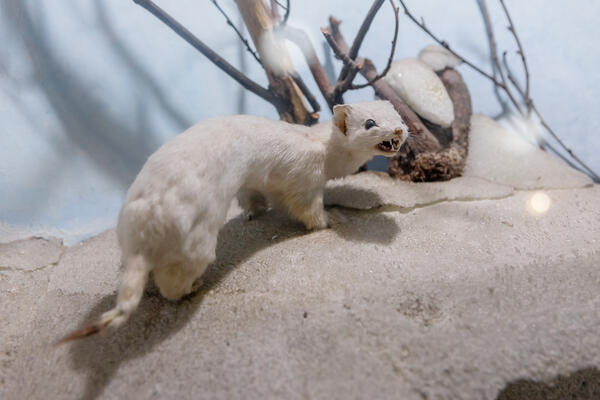The Ivanovo Museum of Local History named after Dmitry Burylin keeps a stuffed common weasel.
The common weasel is an aggressive and fearless hunter and the smallest member of the genus Mustela (of weasels and ferrets), family Mustelidae and order Carnivora. The weasel lives in various types of forests, fields, floodplains, river valleys, mountainous areas and populated places. The choice of a place to live mainly depends on the availability of food and hiding places. In general, a weasel is an elusive animal. The animal runs quickly, climbs trees, swims well and has excellent hunting skills. The weasel’s sharp eyes and keen sense of smell help it to easily find and overtake prey even in the dark. The predator moves by jumping. At a normal speed, the length of the jump is about 25 centimeters, while in case of danger it increases to half a meter. The weasel’s body is elongated and very flexible, which allows it to pursue prey even in very narrow and winding burrows. In summer, the fur becomes brown in the upper part of the body and white in the lower part. In winter, the weasel becomes completely white. The body length ranges between 13 and 26 centimeters for males or 11 and 20 centimeters for females. The weight of males does not exceed 250 grams, that of females — 120 grams.
The weasel can be found in a variety of habitats
throughout the Northern Hemisphere. Small rodents and insectivores such as
borers, shrews, and moles make up a major part of the animal’s diet. Apart from
mammals, it also hunts birds and eats their eggs. Occasionally, it feeds on
frogs, snakes and lizards. The weasel’s courage is evident from the large size
of its prey — rabbits, hazel grouse, black grouse and even capercaillie. Such
prey is eaten only partly; usually the weasel starts with the brain. The
territory of one male shares borders with the territories of several females.
Mating takes place in spring or early summer. The further welfare of the
offspring is undertaken by the female. There are usually five or six cubs in a
litter. Their eyes open within the first month of their lives. After
another month, they begin to learn to hunt independently. In the wild, weasels
live up to five years and can live twice as long in captivity. Weasels are not afraid of humans —
upon meeting, they either run away for a short distance and stand on their hind
legs to get a better look or try to attack.



